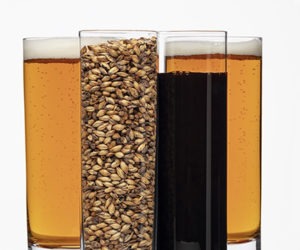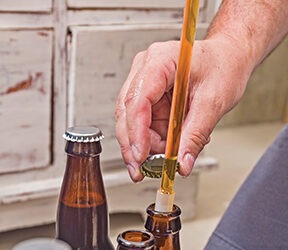Talking Brewer’s Water Lingo

Over the past several issues I’ve covered some of the terminology that surrounds the main ingredients of beer: Malt, yeast, and hops. In my mind, it’s fairly apropos that I saved the last for water. Often it’s the last of the major components of beer that homebrewers explore on a homebrewer’s learning curve. So with that in mind, let’s jump into the topic of understanding water lingo in brewer’s terms.
Water Composition
A water molecule is a fairly simple molecule with two hydrogen atoms covalently bound to an oxygen atom. It’s a highly stable molecule chemically and it exists in three forms on this planet: Gas (vapor), liquid (water), and solid (ice). As most of us know, water boils at 212 °F (100 °C) under 1 atmosphere of pressure (normal pressure at sea level) and freezes at 32 °F (0 °C). Water’s polarity means it acts as a magnet with two ends to each molecule, a positive and a negative end. Polarity drives a lot of the properties we find in water including the fact that these phase-change temperatures are very high for such a small molecule: The magnetic nature of the molecules allows them to stay linked together longer than most similar-sized molecules. The boiling temperature fluctuates as pressure changes but the freeze temperature does not — something of note for high elevation brewers where pressure is lower. Water’s freeze temperature will decrease, though, when things get mixed or dissolved into the water, such as sugar, salt, or ethanol. This allows brewers to lager beers below normal freezing temperatures. Water’s polarity also means that it likes other polar molecules such as ethanol (and many acids, bases), allowing those two to be miscible, or mixed. On the flip side, water does not like non-polar molecules such as oil, meaning those two are immiscible, and will remain separate.
Understanding Brewing Water Salts
Salts dissolve in water in varying rates and their ability to dissolve often depends on certain conditions like the water’s temperature and pH. Some salts dissociate (fall apart) easily such as table salt, while others will not, such as calcium carbonate (chalk). The polarity of water molecules actually pulls certain salt molecules apart. Brewers tend to hone in on a few key salts found in drinking water: Table salt (NaCl), calcium chloride (CaCl2), chalk (CaCO3), gypsum (CaSO4), and Epsom salt (MgSO4). These salts will be found at various levels in their ionic (dissolved) form in typical tap water. Because of their overall effects on the chemistry of the beer and the finished beer’s flavor profile, brewers will often tweak these ion levels by various additions or removal and/or dilution procedures to hone in the beer’s profile.
Acids and Bases
Besides salts, acids and bases often will dissolve easily in water as well. pH is a measure of the level of a compound known as hydronium [H3O]+, a compound that occurs naturally in purified water. A pH of 7 means there are 1 x 10-7 hydronium ions per liter of water. Acidifying the water means you increase the hydronium ions present in solution, dropping the pH below 7. The more hydronium ions, the lower the pH, the more acidic the solution. The less the hydronium ions, the higher the pH, the more basic the solution. For brewers that are looking to acidify water (and wort), brewers can add calcium chloride, gypsum, lactic acid, and/or phosphoric acid. The calcium salts are weak acids in wort (calcium drops pH by reacting with phosphates from malt, creating hydronium ions in the process) while the lactic and phosphoric acid have a higher efficacy for brewers looking to drop the pH. On the flip-side, brewers generally try to avoid stronger alkaline (basic) compounds such as lye (NaOH) but may still add weak alkaline salts like chalk (CaCO3) or baking soda (NaHCO3) if an increase in pH is desired.
Brewer’s Jargon
On brew day, all-grain brewers will use various terms to designate the purpose of various water volumes. Strike water is the water that will get mixed into the grain to start the mash’s conversion. The temperature of the strike water is very important as is the chemical composition (pH and salt levels) since these two factors will help guide enzyme activity in the mash. The next volume of water that is important to all-grain brewers is the sparge water. Sparge water is the water brewers use to help rinse the grains of all the sugar that was created during the mash. The overall composition of sparge water is less important, but during the washing (sparging) phase of the grains, brewers look to avoid the pH of the mash from rising above 5.8. This is called oversparging and only a concern with pale, low-gravity beers. My rule of thumb is to not exceed one and a half times the strike water volume when sparging a low-gravity, pale beer.
Once water picks up sugars from the malts, it is no longer called water, it is now called brewer’s wort. Wort then ferments into beer by brewer’s yeast.
Finally, most brewers utilize chilling water, which is used to bring the wort down to room temperature after the boil. If done properly, some of the cooling water should be repurposed to use as cleaning water as well since it takes a large amount of thermal capacity (water) to bring the wort down from a boil to yeast pitching temperature. If the chilling is done properly, then the chilling water should come up piping hot, perfect for cleaning the sugary wort from your brewing equipment.


